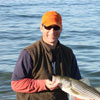5 Surf Fishing Tips for a Thrilling Catch
By Tom Keer
Aug 17, 2016
Catching saltwater fish on the beach is a thrill. Get expert tips and techniques to help you find the angling action!
I heard about last night's hot bite and decided to check it out. When I got to the water it looked dead. I walked about a mile up the sand, and I'm glad I did. The saltwater fish that had been in front of the parking lot had moved, but they were still around.
Surf Fishing Tips
1. Know your structure. Check out the water at dead low tide, preferably around the full or new moon. You'll see bars, ocean holes, and channels. Fish like structure 'cause it's easier for them to pin down the bait. Breakwalls, pilings, kelp or grass beds also offer structure.
2. Fish move into the current. Fish move into the current because the water rushing through their gills brings them oxygen. They'll sometimes swim with the current but only for a short time. Check out the direction in which the current is flowing and you'll know in which direction the fish will move.
3. Don't let the paint dry. Saltwater fish move around with the tides, so if you've put in a reasonable amount of time and haven't had a bump, move. Keep a winning game plan, change a losing game plan.
4. Fan Casting. Cover water with a fan cast. Cast to your left, straight out in front, and then off to the right. Repeat that sequence while varying the distance of your casts. When you've covered the water and haven't had a bump try two different approaches. The first is to change your plug. If you've been working a surface lure, then try a darter or a swimmer to get deeper. If nobody is home, then move down the beach. Cast and walk, cast and walk, and in a short while you'll find the saltwater fish.
5. Retrieve. Small fish are aggressive, and a fast, aggressive retrieve lights 'em up. Short rod twitches combined with quick reeling triggers explosive strikes, and if they miss your plug keep twitching and reeling. They'll whack it harder on the next pass.
Bigger fish are more cautious, so a slower retrieve gets them to hit. To make your plug look natural, twitch, twitch, and twitch your rod during your retrieve. In between each twitch reel quickly to gather your slack line. Always maintain contact with your plug to keep it moving and make it look realistic.
Check in with your local tackle shop, make sure your fishing license is current, and get in on the action!
Surf Fishing Tips
1. Know your structure. Check out the water at dead low tide, preferably around the full or new moon. You'll see bars, ocean holes, and channels. Fish like structure 'cause it's easier for them to pin down the bait. Breakwalls, pilings, kelp or grass beds also offer structure.
2. Fish move into the current. Fish move into the current because the water rushing through their gills brings them oxygen. They'll sometimes swim with the current but only for a short time. Check out the direction in which the current is flowing and you'll know in which direction the fish will move.
3. Don't let the paint dry. Saltwater fish move around with the tides, so if you've put in a reasonable amount of time and haven't had a bump, move. Keep a winning game plan, change a losing game plan.
4. Fan Casting. Cover water with a fan cast. Cast to your left, straight out in front, and then off to the right. Repeat that sequence while varying the distance of your casts. When you've covered the water and haven't had a bump try two different approaches. The first is to change your plug. If you've been working a surface lure, then try a darter or a swimmer to get deeper. If nobody is home, then move down the beach. Cast and walk, cast and walk, and in a short while you'll find the saltwater fish.
5. Retrieve. Small fish are aggressive, and a fast, aggressive retrieve lights 'em up. Short rod twitches combined with quick reeling triggers explosive strikes, and if they miss your plug keep twitching and reeling. They'll whack it harder on the next pass.
Bigger fish are more cautious, so a slower retrieve gets them to hit. To make your plug look natural, twitch, twitch, and twitch your rod during your retrieve. In between each twitch reel quickly to gather your slack line. Always maintain contact with your plug to keep it moving and make it look realistic.
Check in with your local tackle shop, make sure your fishing license is current, and get in on the action!
Popular Posts









